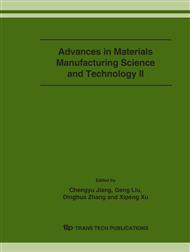p.193
p.197
p.201
p.205
p.209
p.213
p.217
p.221
p.225
Research on Influence of the Material Anisotropy to the Surface Quality during SPDT Machining of Crystal KDP
Abstract:
A theoretical analysis on the variation regularity of cutting force caused by the material anisotropy with different orientation of KDP is analyzed firstly; influence and regularity of the variation are obtained. Analysis result shows that the crystal anisotropy of KDP is an important factor in obtaining the super-smooth surface. Then experiments are realized on the machine tool, results afford the variation regularity of cutting force caused by the anisotropy with different orientation of KDP, which certifies the correctness of this theoretical analysis. For ultra-precision machining of the KDP at large negative rake diamond cutter (-45°) and the optimal parameters, the super-smooth surface (rms is 8.702 nm, Ra is 6.895 nm) can be obtained on the plane (001).
Info:
Periodical:
Pages:
209-212
Citation:
Online since:
December 2006
Authors:
Price:
Сopyright:
© 2006 Trans Tech Publications Ltd. All Rights Reserved
Share:
Citation:


